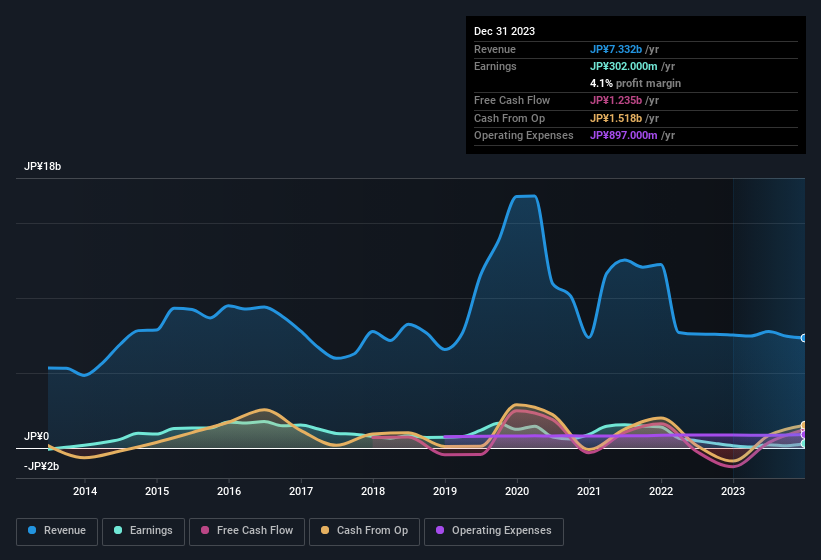Takahashi Curtain Wall's (TSE:1994) Solid Earnings May Rest On Weak Foundations

Following the solid earnings report from Takahashi Curtain Wall Corporation (TSE:1994), the market responded by bidding up the stock price. However, we think that shareholders should be cautious as we found some worrying factors underlying the profit.
View our latest analysis for Takahashi Curtain Wall

Examining Cashflow Against Takahashi Curtain Wall's Earnings
As finance nerds would already know, the accrual ratio from cashflow is a key measure for assessing how well a company's free cash flow (FCF) matches its profit. The accrual ratio subtracts the FCF from the profit for a given period, and divides the result by the average operating assets of the company over that time. You could think of the accrual ratio from cashflow as the 'non-FCF profit ratio'.
That means a negative accrual ratio is a good thing, because it shows that the company is bringing in more free cash flow than its profit would suggest. That is not intended to imply we should worry about a positive accrual ratio, but it's worth noting where the accrual ratio is rather high. That's because some academic studies have suggested that high accruals ratios tend to lead to lower profit or less profit growth.
Takahashi Curtain Wall has an accrual ratio of -0.10 for the year to December 2023. That implies it has good cash conversion, and implies that its free cash flow solidly exceeded its profit last year. Indeed, in the last twelve months it reported free cash flow of JP¥1.2b, well over the JP¥302.0m it reported in profit. Notably, Takahashi Curtain Wall had negative free cash flow last year, so the JP¥1.2b it produced this year was a welcome improvement. However, that's not all there is to consider. We can see that unusual items have impacted its statutory profit, and therefore the accrual ratio.
Note: we always recommend investors check balance sheet strength. Click here to be taken to our balance sheet analysis of Takahashi Curtain Wall.
How Do Unusual Items Influence Profit?
While the accrual ratio might bode well, we also note that Takahashi Curtain Wall's profit was boosted by unusual items worth JP¥59m in the last twelve months. While it's always nice to have higher profit, a large contribution from unusual items sometimes dampens our enthusiasm. We ran the numbers on most publicly listed companies worldwide, and it's very common for unusual items to be once-off in nature. Which is hardly surprising, given the name. If Takahashi Curtain Wall doesn't see that contribution repeat, then all else being equal we'd expect its profit to drop over the current year.
Our Take On Takahashi Curtain Wall's Profit Performance
In conclusion, Takahashi Curtain Wall's accrual ratio suggests its statutory earnings are of good quality, but on the other hand the profits were boosted by unusual items. Having considered these factors, we don't think Takahashi Curtain Wall's statutory profits give an overly harsh view of the business. If you want to do dive deeper into Takahashi Curtain Wall, you'd also look into what risks it is currently facing. For example, Takahashi Curtain Wall has 3 warning signs (and 1 which is potentially serious) we think you should know about.
Our examination of Takahashi Curtain Wall has focussed on certain factors that can make its earnings look better than they are. But there are plenty of other ways to inform your opinion of a company. For example, many people consider a high return on equity as an indication of favorable business economics, while others like to 'follow the money' and search out stocks that insiders are buying. While it might take a little research on your behalf, you may find this free collection of companies boasting high return on equity, or this list of stocks that insiders are buying to be useful.
Valuation is complex, but we're here to simplify it.
Discover if Takahashi Curtain Wall might be undervalued or overvalued with our detailed analysis, featuring fair value estimates, potential risks, dividends, insider trades, and its financial condition.
Access Free AnalysisHave feedback on this article? Concerned about the content? Get in touch with us directly. Alternatively, email editorial-team (at) simplywallst.com.
This article by Simply Wall St is general in nature. We provide commentary based on historical data and analyst forecasts only using an unbiased methodology and our articles are not intended to be financial advice. It does not constitute a recommendation to buy or sell any stock, and does not take account of your objectives, or your financial situation. We aim to bring you long-term focused analysis driven by fundamental data. Note that our analysis may not factor in the latest price-sensitive company announcements or qualitative material. Simply Wall St has no position in any stocks mentioned.
About TSE:1994
Takahashi Curtain Wall
Engages in the PC curtain wall and aqua businesses in Japan.
Excellent balance sheet average dividend payer.
Market Insights
Community Narratives




